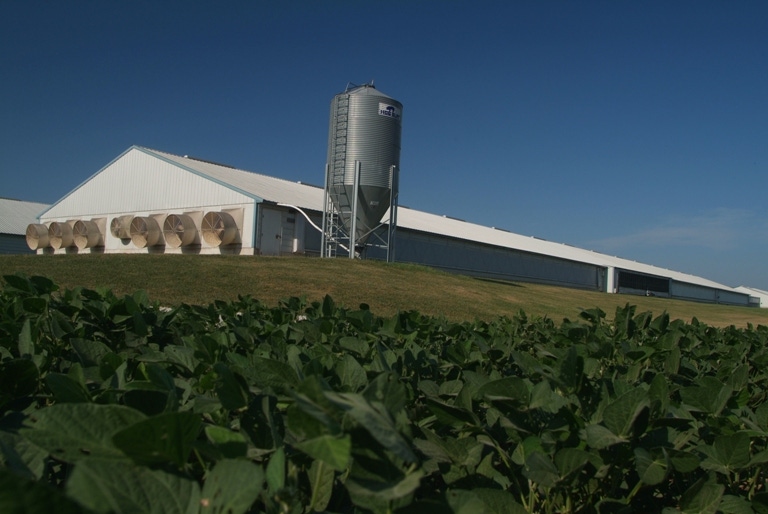July 9, 2013

The “promised land” of lower feed costs will usher in an extended period of profitability, according to a Purdue University Extension economist. Those lower costs are not here yet but could be just weeks away as prospects for U.S. corn and soybean production have improved in recent days.
Producers can see prospects for $2-per-bushel lower cash corn prices by harvest and $130-per-ton lower soybean meal prices in the July to October futures spread. While they see the market’s anticipation of lower feed costs on the near-horizon, they recognize that there are still unknowns about acreage, weather for the remainder of the growing season and the possibility of an early frost. But today’s signals suggest they should begin to get the celebration under way.
“Feed-cost reductions, if realized, will be of record magnitude,” Chris Hurt says. “Estimated total costs for farrow-to-finish hog production will drop from $69 per live hundredweight in the second quarter of 2013 to about $56 in the final quarter of 2013. The $13 drop is the largest on record.”
Hurt explains that the 2012 drought created extreme problems for pork producers and gave them little ability to avoid large losses. Much of the feed price rise occurred in about three weeks from mid-June to early July 2012. This gave pork producers almost no time to adjust their breeding programs and meant that all the pigs “in process” were going to consume very expensive feed and result in losses. In addition, they had little economic incentive to cut back on their breeding herds. This was because the time from breeding to market approaches one year and meant that sows bred in the summer of 2012 would have pigs marketed in the spring and summer of 2013 when the outlook called for a return to profitability.
“The drought put pork producers in a bind,” Hurt says. “It resulted in large losses from mid-2012 to mid-2013. Their best alternative was to keep breeding and hope for more normal crop production in 2013 and for lower feed prices. That hope is now much closer to reality and means the outlook for the next 12 months is the polar opposite of the past 12 months,” he says.
Compared to the last 12 months, Hurt says that corn prices are expected to be nearly $2 per bushel lower in the coming 12 months. Soybean meal prices are expected to be about $100 per ton lower on average. The combination of these two factors reduces estimated total costs by about $13 per live hundredweight. Hog prices are expected to be somewhat higher in the next 12 months as well.
“The bottom line is that losses of $21 per head during the last 12 months will give way to projected profits of $16 per head in the 12 months spanning the last half of 2013 and the first half of 2014,” Hurt says.
Like what you’re reading? Subscribe to the National Hog Farmer Weekly Preview newsletter and get the latest news delivered right to your inbox every week!
In the June Hogs and Pigs report from the U.S. Department of Agriculture, producers who were surveyed in early June were keeping any expansion plans on hold, waiting to see if crop production would be restored in 2013. “The size of the spring pig crop was unchanged from the previous year reflecting a status-quo attitude in the industry,” Hurt says. “Summer farrowing intentions were also unchanged and fall farrowing intentions were up slightly.”
Hurt adds that given the increasing realization of better crop production, pork producers are expected to begin some modest expansion late this summer and especially in the fall. The industry is expected to be profitable at least through next summer. This expansion may be in the 1 to 3% range over the coming year.
“In the longer run, producers will want to examine the yet-to-be-answered question of where feed prices will settle,” Hurt says. “Corn prices under $5.50 per bushel could stimulate some expansion. The farther below $5.50 they go, the greater the expansion stimulus will be.
“Many analysts, including me, believe markets are entering a period in which grain and oilseed supplies will catch up to demand growth,” Hurt says. “This means a period of increasing crop inventories, reduced feed prices and reduced feed price volatility. All in all, a more favorable financial period for animal producers is expected. It should also be a period of increased animal production and recovering per capita consumption by our domestic and foreign meat customers,” he says.
Hurt concludes that the last six years have been an unusual period for the pork industry in that feed costs have often been the biggest single driver of the financial outlook.
“If crop production returns to more normal levels, feed costs will be less important and the industry will see the primary drivers shift to pork supplies, domestic meat demand and exports,” he says. “Pork producers can see the new era from current forward prices, and in another 30 to 60 days they may have the opportunity to cross over into that promised land.”
You might also like:
Pork Exports Still Down, but Domestic Consumption Shows Strength
New Data Tracking Helps Identify Top Production
10 Tips for Young Pork Producers
You May Also Like



